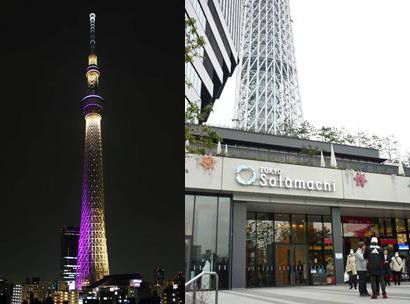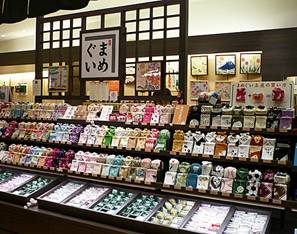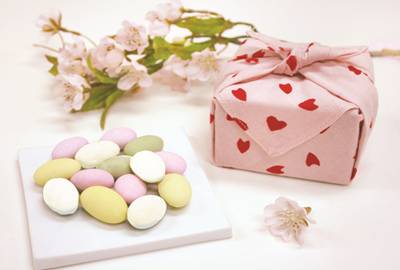
Tokyo Skytree Town has become a new tourist site in Tokyo since its opening in May, 2012. For Japanese people, now it is the best place to visit.
Tokyo Skytree Town is comprised of Tokyo Skytree, a 634-meter tall broadcasting tower, commercial facilities, and offices. This tower was built as we needed a new broadcasting tower that would be much higher than the former one, Tokyo Tower. While Tokyo Tower has a shape similar to the Eiffel Tower in Paris, the new tower is leaner than the old one. When illuminated, while Tokyo Tower is lit up with modern colors, the new tower emits a light of specially-designed blue or purple, which looks graceful in the eyes of Japanese people.
The concept of Tokyo Skytree Town is “Rising East.” It promotes the rebirth of shitamachi, the traditional old town area in Tokyo, and the creation of a new community. For some reason, these days the lifestyle of the Edo period (1603-1868), during which people lived the most ecological life in the world, has gained great interest among people in Japan. In the middle of the Edo period, the city of Edo was the world’s largest city with a population of one million, as well as the world’s safest place with the smallest number of crimes committed in the world. It is said at the time there were only 30 police officers in the city. It’s unbelievable, isn’t it? And the area surrounding the Tokyo Skytree is the very place where you can feel the warmth, vigorousness, and lifestyles of the people of the day, and where you can buy traditional souvenirs.
During the Edo period, in the city of Edo (Tokyo), the upland part where samurai residences were located was called “yamanote” while the commercial and industrial area for town people was called “shitamachi.” The area around which the Tokyo Skytree Town is located belongs to shitamachi, along with Nihombashi, Kanda and Asakusa.
Shitamachi was the town of craftsmen, and still is.
There are some family-run workshops in this area where those craftsmen carry on Edo-period traditions with various kinds of their handicrafts.
If you want to buy shitamachi-style souvenirs, especially the old-fashioned ones from the Edo period, we recommend you go and shop at Tokyo Soramachi, the shopping district of the Town.
In this shopping district there are so many kinds of establishments including souvenirs shops, restaurants, fashion and sundry goods stores, delicatessens and confectioneries, all crowded with so many shoppers.
First, let’s go up to the fourth floor for Japanese souvenirs.
On this floor, you can shop for different kinds of sundries, replica foods, cosmetics, etc.
Here, we highly recommend you visit the store ‘mamegui,’ and pick some tenugui, dyed cloths made from cotton, for your Edo-style souvenirs. The shop offers its handkerchief-size small tenugui designed with many different print patterns, from which you can enjoy the spirit of shitamachi.

People of the Edo period loved festivals very much, and tenugui is an essential item for the event. They used tenugui with many different printed patterns, and when a pattern design was considered iki (which means edgy and cool), the tenugui with the pattern became very popular. Tenugui was a versatile item in the kitchen and the bath. While they were working, they hung it at their side to wipe their sweat.
Usually tenugui is around 70 centimeters by 40 centimeters, since it was also used to cover their heads.
Boys of the Edo period used new tenugui only on the day of a festival. They wore the tenugui as a headband, tightly twisted, and carried mikoshi (a portable shrine) naked to the waist to show off their toned muscles. For boys, this moment was an ideal opportunity to make an appeal to girls how sexy they were. Therefore, it was important for them to use brand-new tenugui.
Those who knew how to look cool adding a new twist to how they wore the tenugui headband were popular among women. So the boys devoted themselves to finding their new look with the headband using tenugui, the rectangle cloths dyed in different shades of blue and brown. Interesting, isn’t it?

At ‘mamegui’, pick up your tenugui and small candies and go to the cash register, and the staff will put the candies into a box and wrap it beautifully with the tenugui you choose. The tenugui you can buy at this store are half-sized compared to the traditional tenugui mentioned above, but those items must be cute souvenirs; you can just hand them to people.
Also, we recommend you get this tenugui and the matching frame for your room decoration. If you were from overseas and brought those tenugui souvenirs home, those who receive the gift would say, “It’s so cool!!”
Reported by Yukari Aoike and Akiko Sugahara, Sugahara Institute
